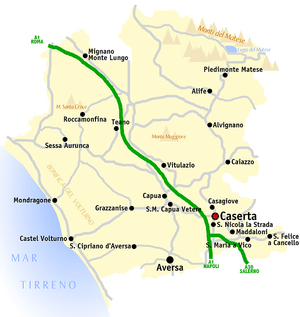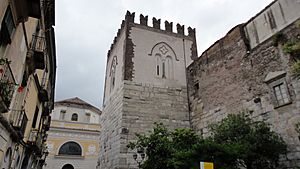Province of Caserta facts for kids
Quick facts for kids
Province of Caserta
|
|
|---|---|

Monti Trebulani
|
|

Map highlighting the location of the province of Caserta in Italy
|
|

Map of the Province of Caserta
|
|
| Country | |
| Region | Campania |
| Capital(s) | Caserta |
| Comuni | 104 |
| Area | |
| • Total | 2,651.35 km2 (1,023.69 sq mi) |
| Population
(1 January 2016)
|
|
| • Total | 924,414 |
| • Density | 348.6579/km2 (903.0197/sq mi) |
| Time zone | UTC+1 (CET) |
| • Summer (DST) | UTC+2 (CEST) |
| Postal code |
81100 Caserta, 81010-81059 other communes
|
| Telephone prefix | 081, 0823 |
| Vehicle registration | CE |
| ISTAT | 061 |
The Province of Caserta (called Provincia di Caserta in Italian) is a special area, or province, in the Campania region of Italy. Its main city, or capital, is Caserta. This city is about 36 kilometers (22 miles) north of Naples.
The province covers an area of about 2,651 square kilometers (1,024 square miles). In 2016, around 924,414 people lived there. A very famous building, the Palace of Caserta, is located near the city. This huge palace was built for the kings of Naples from the Bourbon family. It was the biggest palace and one of the largest buildings made in Europe during the 1700s. In 1997, the palace became a UNESCO World Heritage Site, which means it's a very important place to protect.
History of Caserta Province
The area known today as the Province of Caserta was once part of a historical region called Terra di Lavoro, or Liburia. Around the 1200s, this region was very large. It stretched from the Tyrrhenian Sea and its islands, like Ponza and Ventotene, all the way to the Apennines mountains.
In the past, during the time of the Kingdom of Naples and the Kingdom of the Two Sicilies, Caserta was a very important part of southern Italy. The first capital of this region was the ancient city of Capua. This lasted until 1818, when Caserta became the new capital.
Other important towns in the region included Naples, Nola, Gaeta, Sora, Aversa, Teano, and Isola Liri. In 1816, when the French were in charge, Joseph Bonaparte changed how the kingdom was divided. He created new local areas, similar to the French communes. This led to the creation of the Province of Naples.
Later, in 1863, after Italy became one country, some towns from Terra di Lavoro joined the province of Campobasso. Other areas, like Venafro, moved to the province of Isernia in the 1870s. In 1927, Benito Mussolini decided to break up the province of Terra di Lavoro. Many of its areas, including the Pontine Islands, became part of the province of Naples. Some towns near Piedimonte and Alife were split between the provinces of Benevento and Campobasso. The areas of Sora and Gaeta went to the province of Rome.
Finally, in 1945, a special order signed by Umberto di Savoia brought the Province of Caserta back. The modern province we know today was fully formed in 1970.
Geography of Caserta Province
The Province of Caserta is located in the southwestern part of central Italy. To the north, you can find the Matese mountains, which are part of the Apennines. There are also rolling hills in this area. To the south and west, the land is mostly flat plains.
Near the Matese mountains in the northeast, there is a lake called Lago del Matese. The highest point in the province is Monte Miletto, which is about 2,050 meters (6,726 feet) tall. This mountain is shared between the regions of Campania and Molise. The rocky area around it has lots of water and minerals, with many caves and mountain lakes.
Other important mountains include Monte Santa Croce, which has an old volcano called Roccamonfina. This mountain is on the border with Lazio. The Trebulani Mountains are in the central part of the province to the north. Here, Monte Maggiore reaches about 1,036 meters (3,399 feet). To the south, you'll find the Tifatini Mountains.
The Volturno River flows right through the middle of the province. The town of Capua, with its old defenses, is located along this river. The southern highlands of Caserta are next to the Province of Benevento.
See also
 In Spanish: Provincia de Caserta para niños
In Spanish: Provincia de Caserta para niños


